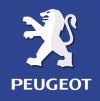

| Opel / Vauxhall (Germany / UK) |
 Headquarters:
Paris, France.
Headquarters:
Paris, France.Main plants :
France: Sochaux (308, 3008, 5008), Mulhouse (206+, 308, C4), Poissy (207, C3, DS3), Aulnay (C3), Rennes (407, 508, 607, C5, C6)
Spain: Vigo (C4 Picasso, Partner, Berlingo), Madrid (207, C3)
Italy: Sevel (JV with Fiat) (Boxer, Relay)
Slovakia: Trnava (207, C3 Picasso)
Czech: Kolin (JV with Toyota) (107, C1)
Brazil: Porto Real (206, C3, Xsara Picasso)
Argentina: Buenos Aires (206, 307, C4, Berlingo, Partner)
China: Wuhan (JV with Dongfeng) (206, 307, 408, C2, C4, C5)
Remark: production of RCZ subcontracted to Magna-Steyr at Graz, Austria.
2018: 3,877,765 units (including 1,038,057 units of Opel/Vauxhall)
2017: 3,228,381 units (+ 403,933 units of Opel/Vauxhall since acquistion)
2016: 3,146,382 units
2015: 2,972,791 units
2014: 2,938,372 units
2013: 2,817,576 units
2012: 2,964,910 units
2011: 3,549,416 units
2010: 3,602,200 units
2009: 3,188,000 units
2008: 3,260,400 units
2007: 3,428,400 units
2006: 3,365,900 units
2005: 3,390,000 units
2004: 3,375,000 units
2003: 3,286,100 units
2002: 3,267,500 units
2001: 3,132,800 units
2000: 2,815,700 units
1999: 2,518,600 units
2018 sales by brand:
Peugeot: 1,740,214 units
Citroen: 1,046,229 units
DS: 53,265 units
Opel / Vauxhall: 1,038,057 units
2018 sales by models:
Peugeot
108: 59,573 units
206: 60,800 units
208: 294,876 units
2008: 218,640 units
301: 46,240 units
308: 209,560 units
3008: 265,125 units
405: 80,252 units
408: 30,421 units
4008: 29,436 units
508: 17,395 units
5008: 109,900 units
Partner: 145,243 units
Citroen
C1: 52,754 units
C3: 252,117 units
C3 Aircross: 122,813 units
C-Elysee: 67,251 units
C4 Cactus: 78,908 units
C4: 44,479 units
C4 Picasso: 76,433 units
C4 Aircross: 781 units
C5: 5,082 units
C5 Aircross: 29,779 units
C6: 3,925 units
Berlingo: 159,792 units
DS
DS3: 16,187 units
DS4: 5,381 units
DS5: 2,756 units
DS6: 592 units
DS7 Crossback: 27,786 units
Reference:
http://www.psa-peugeot-citroen.com/en/analysts-and-investors/financial-results
The Peugeot family established a solid financial basis since the early 19th century by producing various industrial products, including bicycle. In 1890, just 4 years after Carl Benz and Gottlieb Daimler invented motor cars, Armand Peugeot produced his first 4-wheel motor vehicle based on his quadricycle and a Daimler engine. A few more models were developed before he founded "Société des Automobiles Peugeot" in 1896, the company we simply refer to "Peugeot" today.
Next year, Peugeot also made its own engine. In the next few years, it introduced numerous industry's firsts, such as steering wheel, pneumatic tires (by Michelin) and transmission shaft with universal joint (instead of chain). Another stunning design was the Grand Prix car in 1912, which used hemi-spherical combustion chambers with cross-flow head and 4 valves per cylinder driven by twin overhead camshafts. It sounds sophisticated even today.
By 1920s, Peugeot's lineup had already covered small cars, mid-range cars and large cars. However, what brought it the first taste of mass production was the opening of Sochaux plant and the introduction of 201 in 1929. This economical model helped it to survive the Great Depression in 1930s and recorded 140,000 units of sales. It also introduced a new nomenclature that is still being used today.
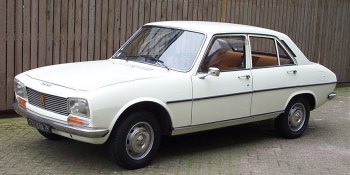 1968 Peugeot 504
1968 Peugeot 504After the Second World War, Peugeot switched to a single-model policy with 203, followed by the Pininfarina-designed 403 and 404. Production scale increased gradually together with the economy of Western Europe. This can be seen from the total sales of its cars: 686,000 units of 203, 1 million units of 403 and 2.9 million units of 404. In the mid-1960s, Peugeot reverted to multiple-models strategy with the introduction of a new entry-level small car called 204, which was the company's first front-wheel drive car. Later on, the mid-size 504 found even greater success and set a new sales record of 3.7 million copies. However, the post-war Peugeot was associated with a conservative image as its cars rarely delivered any innovations, especially compared with local rival Citroen.
In 1965, the company underwent massive expansion, becoming Peugeot S. A. (PSA), a holding company controlling all the group's different companies. PSA received the bankrupted Citroen in 1976 and the falling European Chrysler-Simca in 1978. The group replaced the latter by launching a new marque, Talbot, but it would not survive beyond 1986.
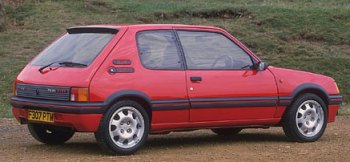 1983 Peugeot 205
1983 Peugeot 205The failure of its expansion drove PSA into losses in the early 1980s. Fortunately, the new 205 hatchback arrived just in time. Thanks to its stylish design, strong engines and great handling, the little car set sales record again at 5.3 million units during its 15 years life. Its hot version, 205 GTI, injected a youthful image to Peugeot. The same went for the mid-engined 4-wheel-drive turbocharged rally car 205 T16 which won 2 WRC manufacturer titles and 3 consecutive victories at Paris-Dakar rally.
The fortune of Peugeot kept growing in the 1990s as it produced many more excellent cars, such as 405, 106, 306 and 406. During this period, Peugeot cars were generally praised for style, ride and handling. Such acclaims were not repeated in the next decade as the new generation 206, 207, 307, 407 and 607 did not match their predecessors in those areas. In addition to the stiffer competition from Japanese and Korean rivals in the European market, Peugeot had its sales going flat since the mid-2000s.
Citroen
In contrast to Peugeot, Citroen used to be the focus of the world’s car lovers. It was founded by Andre Citroen, who had been rich during the WW I by producing military goods. He was regarded as a great talent of business, with clear vision, motivation and enthusiasm about cars. The success of Citroen was mostly due to his leadership.
Having earned enough money, Andre Citroen converted his factories to build cars. The first model was Type A, in 1919, which was recognized as the first mass production car in Europe. More models were introduced and, by the mid-1920s, Citroen became the largest car maker in Europe, trailing only Ford and GM in the world. This was partly because of its innovative technology, such as all-steel monocoque body (in place of conventional wood and steel sheet lamination) and front-wheel drive. Another important contribution was the way he made business - he treated car making as not only selling a good but also associated services. He founded the world's first credit company for car industry, helping customers to finance the purchase. He established dealers and servicing networks to help marketing his cars and provide after sales services. He also introduced the world's first 1-year free warranty.
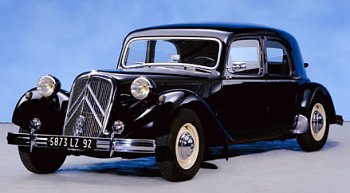 1934 Traction Avant
1934 Traction AvantIn the product side, Citroen introduced its famous Traction Avant in 1934. This car employed front-wheel drive and steel monocoque body instead of body-on-frame construction to lower center of gravity hence greatly improved its roadholding. It also employed advanced features like overhead-valve engine, all-independent suspensions, hydraulic brakes and Michelin radialply tires. It was so advanced for its time that it would continue to serve Citroen until 1957.
However, the aggressive growth of Citroen resulted in heavy debt. When the world was hit by the Great Depression in the 1930s, Citroen went into financial trouble. In 1934, it was received by Michelin, its main creditor. Andre Citroen died the next year due to serious illness.
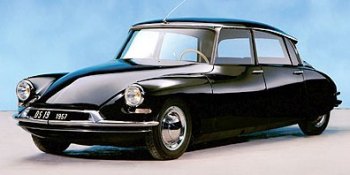 1955 DS
1955 DSThe post-WWII Citroen continued introducing innovative cars. The 1955 Citroen DS shocked the world by its space-age looks as well as its advanced features, such as self-leveling hydropneumatic suspensions, aerodynamic body, power steering, servoed brakes and steering headlamps. The 1970 SM was a space-age luxurious grand tourer powered by a Maserati quad-cam V6 (Maserati would become its subsidiary from 1971-75).
However, the most popular post-war Citroen was 2CV, an odd-looking low-cost little car designed for farmers. Citroen sold more than 5 million copies of this car from 1948 to 1990. Its popularity and ever-green image matched that of Volkswagen Beetle.
No matter which models, all Citroens before the mid-1980s were unique in looks and engineering from contemporary cars. They attracted a crowd of fans, although many other customers were upset by their poor reliability due to the sophistication.
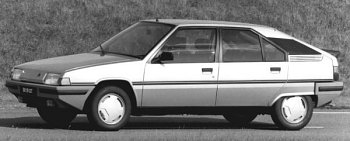 1982 BX
1982 BXAs PSA (Peugeot) took over Citroen from Michelin in 1976, it began integrating the R&D and factories of both companies. To lift economy of scale, common purchasing was adopted, which ruled out the unique technologies of Citroen. After CX, BX and XM, all Citroen new cars adopted platforms common with their Peugeot siblings. This created a range of boring Citroens - AX and ZX, then Saxo, Xsara and Xantia. Nevertheless, the unsophisticated lineup actually brought more sales and turned its balance sheet to black again.
In the new millenium, PSA realized the need to differentiate its two brands. Though still utilized common platforms and powertrains, Citroen was given more freedom in styling and packaging. This created C3, C4 and C6 which looked and felt very different from the related Peugeots.
In 2017, PSA acquired Opel/Vauxhall from General Motors.